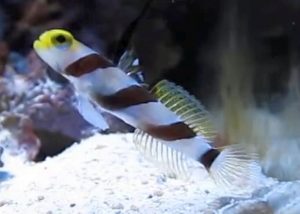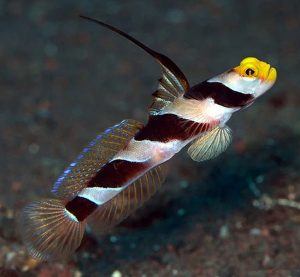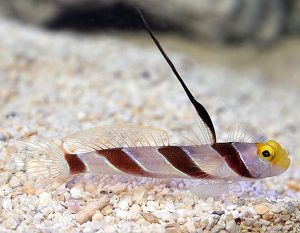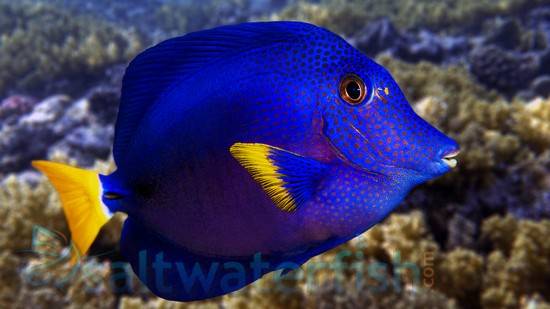The Hi Fin Red Banded Goby (Stonogobiops nematodes) known to tropical fish keeping enthusiasts as the Striped Goby, Blackray Shrimp Goby, Yellow Nose Goby, Filament-finned prawn-goby, Antenna Goby, High-fin Goby, Red-banded Goby, and Barber-pole Goby is native to the western Pacific and Indian Ocean from the Seychelles to the Philippines, and Bali.
The Hi Fin Red Banded Goby is usually encountered in pairs hovering just above the bottom of the deep coastal reef slopes and sandy flats of their range at depths from 49 to over 150 feet. They are normally seen in close proximity to the entrance of their burrows that they often share with Pistol (alpheid) shrimps among the sandy rubble substrate. The majority of their time is spent searching for scraps of food in the water column as they hover about two inches above their escape hole. When startled they will slowly retreat towards their hole or quickly dart inside until the perceived danger is gone.
Stonogobiops nematodes is one of several species that form symbiotic partnerships with the almost blind Randall’s Pistol Shrimp (Alpheus randalli). The shrimp digs and maintains the burrow, while the goby keeps watch for predators. When the shrimp is working on the burrow, it stays in contact with the goby with it’s antennae. When the goby detects a predator, the quivering motion of its caudal fin alerts the shrimp to immediately retreat into the burrow, quickly followed by the goby. The shrimp closes the entrance to the burrow at night, leaving only one entrance open at any give time. Alpheus randalli seldom emerge from their burrows without close contact with the goby.
The Hi Fin Red Banded Goby has a yellow head and a silver-white body with distinct dark brown diagonal stripes across the body. Both sexes have a striking pointed dorsal fin that increases in size and becomes more pronounced as they grow into adulthood. This elongated fin is the most obvious distinguishing feature between the Hi Fin Red Banded Goby and its close cousin, the Yellow Snout Goby (S. xanthorhinica). Males and females are virtually indistinguishable.
The Hi Fin Red Banded Goby is best housed in a reef or passive FOWLR aquarium of at least 10 gallon capacity, with a deep substrate of small grain coral sand mixed with larger particles of coral rubble for them to burrow into and plenty of live rock for them to hide among. A tightly fitting tank cover is recommend to keep them from jumping out of the tank when startled.
The Hi Fin Red Banded Goby is a shy, docile species that is best kept as mated pairs when possible. Their passiveness makes them a perfect tankmate for delicate species like sea horses, pipefish, and the red and white barred shrimp (Alpheus randalli). Because other fish, corals, and invertebrates are normally left alone by Stonogobiops nematodes, they are an ideal choice for reef tanks.
The Hi Fin Red Banded Goby can occasionally display aggression towards other tank tankmates by opening its mouth and yawning at them, however, this is mostly show. Individual males may actually fight when housed in aquariums smaller than about 50 gallons.
Mated Stonogobiops nematodes pairs are very rare and difficult to acquire. Although they have spawned in a home aquarium environment, there have been no reports from tropical fish keeping enthusiasts of successfully rearing the larvae past settlement. Prior to spawning, the belly of the female becomes noticeably swollen with eggs. Spawning usually occurs inside a cave or under a rock where an egg mass is deposited by the female and fertilized by the male. Depending on water temperature, the fertilized eggs hatch out within 5 or 6 days. The small larvae take about a month or so to undergo metamorphosis.
In their natural environment, the Hi Fin Red Banded Goby feeds on zooplankton and other small foods drifting in the water column. In an aquarium environment, they will consume a wide variety of meaty foods including Mysis shrimp, vitamin enriched brine shrimp, finely chopped krill, chopped prawns, carnivore pellets, chopped table shrimp, etc. If they are reluctant to feed when first introduced into the tank, use a turkey baster to direct the offering to where the goby is hiding. Feeding small portions 3 to 4 times a day is recommended.
The Hi Fin Red Banded Goby (Stonogobiops nematodes) is available to tropical fish keeping enthusiasts as wild caught specimens from online retailers, wholesalers, and transhippers. Prices for approximate purchase sizes Small: 1/2″ to 1″; Medium: 1″ to 1-1/2″; Large: 1-1/2″ to 2″ vary from $ 39.99 for small specimens to over $ 69.99 for large.
Minimum Tank Size: 10 gallon (55 gallons for pairs)
Aquarium Type: Reef or FOLR
Care Level: Moderate
Temperament: Peaceful
Aquarium Hardiness: Hardy
Water Conditions: 72-78° F, dKH 8 – 12°, pH 8.1–8.4, sg 1.020-1.025
Max size: 2.5″
Color Form: Brown, White, Yellow
Diet: Carnivore
Compatibility: Reef Safe
Origin: Indo Pacific
Family: Gobiidae
Lifespan: 5 years
Aquarist Experience Level: Intermediate




